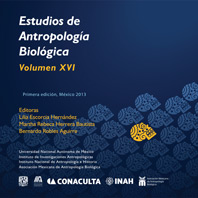San Miguel Albarradas: interpretaciones culturales de un espacio funerario
DOI:
https://doi.org/10.22201/iia.14055066p.2013.56678Palabras clave:
práctica mortuoria, osario, tumba, OaxacaResumen
La tumba de San Miguel Albarradas, Villa de Mitla, Oaxaca, es un espacio funerario con características arqueológicas únicas, sobre todo, en la distribución y deposición de los restos esqueléticos humanos. Dicho contexto presentó un osario de 75 individuos sin conexión anatómica y ofrenda variada. El objetivo es mostrar un trabajo interdisciplinario entre la osteología antropológica y la arqueología para generar una interpretación que responda a tan peculiar suceso mortuorio. Los resultados muestran que los restos esqueléticos fueron removidos de su primer depósito funerario y posteriormente depositados de forma intencional en la tumba. Debido a los materiales encontrados y el orden que pudieron tener, esta tumba podría responder a una práctica mortuoria única en el área.
Descargas
Descargas
Publicado
Cómo citar
Número
Sección
Licencia

http://creativecommons.org/licenses/by-nc-nd/4.0/


